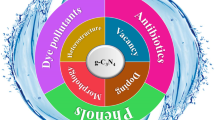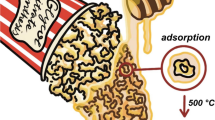Abstract
The particle size, size distribution and photostability of CdS nanoparticles incorporated onto mesoporous TiO2 films by a successive ionic layer adsorption and reaction (SILAR) method were investigated by Raman spectroscopy, UV–Visible spectroscopy, transmission electron microscopy (TEM) and X-ray photoelectron spectroscopy (XPS). High-resolution TEM indicated that the synthesized CdS particles were hexagonal phase and the particle sizes were less than 5 nm for up to nine SILAR deposition cycles. Quantum size effect was found with the CdS-sensitized TiO2 films prepared with up to nine SILAR cycles. The band gap of CdS nanoparticles decreased from 2.65 to 2.37 eV with the increase of the SILAR cycles from 1 to 11. The investigation of the stability of the CdS/TiO2 films in air under illumination (440.6 μW/cm2) showed that the photodegradation rate was up to 85 % per day for the sample prepared with three SILAR cycles. XPS analysis indicated that the photodegradation was due to the oxidation of CdS, leading to the transformation from sulphide to sulphate (CdSO4). Furthermore, the degradation rate was strongly dependent upon the particle size of CdS. Smaller particles showed faster degradation rate. The size-dependent photo-induced oxidization was rationalized with the variation of size-dependent distribution of surface atoms of CdS particles. Molecular dynamics-based theoretical calculation has indicated that the surface sulphide anion of a large CdS particle such as CdS made with 11 cycles (CdS × 11, average particle size = 5.6 nm) accounts for 9.6 % of the material whereas this value is increased to 19.2 % for (CdS × 3)-based smaller particles (average particle size = 2.7 nm). The photostability of CdS nanoparticles was significantly enhanced when coated with ZnS particles deposited with four SILAR cycles. The growth mechanism of ZnS upon CdS nanoparticles was discussed.







Similar content being viewed by others
References
Abdulkhadar M, Thomas B (1995) Study of raman spectra of nanoparticles of CdS and ZnS. Nanostruct Mater 5:289–298
Balandin A, Wang KL, Kouklin N, Bandyopadhyay S (2000) Raman spectroscopy of electrochemically self-assembled CdS quantum dots. Appl Phys Lett 76(2):137–139
Bandaranayake RJ, Wen GW, Lin JY, Jiang HX, Sorensen CM (1995) Structural phase behavior in II–VI semiconductor nanoparticles. Appl Phys Lett 67:831
Cheng SL, Fu WY, Yang HB, Zhang LN, Ma JW, Zhao H, Sun ML, Yang LH (2012) Photoelectrochemical performance of multiple semiconductors (CdS/CdSe/ZnS) cosensitized TiO2 photoelectrodes. J Phys Chem C 116:2615–2621
Correa-Duarte MA, Giersig M, Liz-Marzan LM (1998) Stabilization of CdS semiconductor nanoparticles against photodegradation by a silica coating procedure. Chem Phys Lett 286(5–6):497–501
Dzhagan VM, Ya Valakh M, Raevskaya AE, Stroyuk AL, Ya Kuchmiy S, Zahn DRT (2007) Resonant Raman scattering study of CdSe nanocrystals passivated with CdS and ZnS. Nanotechnology 18:285701
Everall N (2004) Depth profiling with confocal Raman microscopy, Part 1. Spectrosc 19(10):22–27
Friel JJ (1995) X-ray and image analysis in electron microscopy. Princeton Gamma-Tech Inc. Press, Princeton, USA
Gaponenko SV (1998) Optical properties of semiconductor nanocrystals. Cambridge University Press, Canbridge, p P64
Grünwald M, Geissler PL, Rabani E, (2012) Transferable pair potential for CdS and ZnS crystals, Arxiv Preprint arXiv: 1201.2992
Guijarro N, Campina JM, Shen Q, Toyoda T, Lana-Villarreal T, Gómez R (2011) Uncovering the role of the ZnS treatment in the performance of quantum dot sensitized solar cells. Phys Chem Chem Phys 13:12024–12032
Hines DA, Becker MA, Kamat PV (2012) Photoinduced surface oxidation and its effect on the exciton dynamics of CdSe quantum dots. J Phys Chem C 116:13452–13457
Hodes G (2008) Comparison of dye- and semiconductor-sensitized porous nanocrystalline liquid junction solar cells. J Phys Chem C 112(46):17778–17787
Im SH, Kim H-J, Seok SI (2011) Near-infrared responsive PbS-sensitized photovoltaic photodetectors fabricated by the spin-assisted successive ionic layer adsorption and reaction method. Nanotechnology 22:395502
Jung SW, Kim JH, Kim H, Choi CJ, Ahn KS (2011) CdS quantum dots grown by in situ chemical bath deposition for quantum dot-sensitized solar cells. J Appl Phys 110(4):044313
Lee HJ, Chen P, Moon S-J, Sauvage F, Sivula K, Bessho T, Gamelin DR, Comte P, Zakeeruddin SM, Seok SI, Gratzel M, Nazeeruddin MK (2009a) Regenerative PbS and CdS quantum dot sensitized solar cells with a cobalt complex as hole mediator. Langmuir 25(13):7602–7608
Lee HL, Issam AM, Belmahi M, Assouar MB, Rinnert H, Alnot M (2009b) Synthesis and characterizations of bare CdS nanocrystals using chemical precipitation method for photoluminescence application. J Nanomater. Art no. 914501
Lee YH, Im SH, Rhee JH, Lee JH, Il Seok S (2010a) Performance enhancement through post-treatments of CdS-sensitized solar cells fabricated by spray pyrolysis deposition. ACS Appl Mater Interfaces 2(6):1648–1652
Lee HJ, Bang JW, Park JW, Kim SJ, Park S-M (2010b) Multilayered semiconductor (CdS/CdSe/ZnS)-sensitized TiO2 mesoporous solar cells: all prepared by successive ionic layer adsorption and reduction processes. Chem Mater 22:5636–5643
Lichtman D, Craig JH Jr, Saller V, Drinkwine M (1981) AES and XPS spectra of sulfur-compound. Appl Surf Sci 7(4):325–331
Nicolau YF, Menard JC (1988) Solution growth of ZnS, CdS and Zn1−x Cd x S thin films by the successive ionic-layer adsorption and reaction process: growth mechanism. J Cryst Growth 92:128–142
Peter LM (2011) The gratzel cell: where next? J Phys Chem Lett 2(15):1861–1867
Razik NA (1987) Use of a standard reference material for precise lattice parameter determination of materials of hexagonal crystal structure. J Mater Sci Lett 6:1443–1444
Robel I, Subramanian V, Kuno M, Kamat PV (2006) Quantum dot solar cells. Harvesting light energy with CdSe nanocrystals molecularly linked to mesoscopic TiO2 films. J Am Chem Soc 128:2385–2393
Ruhle S, Shalom M, Zaban A (2010) Quantum-dot-sensitized solar cells. ChemPhysChem 11(11):2290–2304
Shen Q, Kobayashi J, Diguna LJ, Toyoda T (2008) Effect of ZnS coating on the photovoltaic properties of CdSe quantum dot-sensitized solar cells. J Appl Phys 103(8):084304
Spanhel L, Haase M, Weller H, Henglein A (1987) Photochemistry of colloidal semiconductors. 20. Surface modification stability of strong luminescing CdS particles. J Am Chem Soc 109(19):5649–5655
Sun Q, Wang YA, Li LS, Wang DY, Zhu T, Xu J, Yang CH, Li YF (2007) Bright, multicoloured light-emitting diodes based on quantum dots. Nat Photonics 1(12):717–722
Vogel R, Hoyer P, Weller H (1994) Quantum-sized PbS, CdS, Ag2S, Sb2S3, and Bi2S3 particles as sensitizers for various nanoporous wide-bandgap semiconductors. J Phys Chem 98(12):3183–3188
Wang Y, Herron N (1991) Nanometer-sized semiconductor clusters: materials synthesis, quantum size effects, and photophysical properties. J Phys Chem 95(2):525–532
Wang HX, Peter LM (2012) Influence of electrolyte cations on electron transport and electron transfer in dye-sensitized solar cells. J Phys Chem C 116(19):10468–10475
Wang H, Bai YS, Zhang H, Zhang ZH, Li JH, Guo L (2010a) CdS quantum dots-sensitized TiO2 nanorod array on transparent conductive glass photoelectrodes. J Phys Chem C 114(39):16451–16455
Wang HX, Nicholson PG, Peter LM, Zakeeruddin SM, Gratzel M (2010b) Transport and interfacial transfer of electrons in dye-sensitized solar cells utilizing a Co(dbbip)2 redox shuttle. J Phys Chem C 114(33):14300–14306
Wang XB, Li WW, Sun K (2011a) Stable efficient CdSe/CdS/ZnS core/multi-shell nanophosphors fabricated through a phosphine-free route for white light-emitting-diodes with high color rendering properties. J Mater Chem 21(24):8558–8565
Wang HX, Liu MN, Zhang M, Wang P, Miura H, Cheng Y, Bell J (2011b) Kinetics of electron recombination of dye-sensitized solar cells based on TiO2 nanorod arrays sensitized with different dyes. Phys Chem Chem Phys 13(38):17359–17366
Wang HX, Liu MN, Yan X, Bell J (2012) Reduced electron recombination of dye-sensitized solar cells based on TiO2 spheres consisting of ultrathin nanosheets with [001] facet exposed. Beilstein J Nanotechnol 3:378–387
Xiong QH, Wang JG, Reese O, Lew Yan Voon LC, Eklund PC (2004) Raman scattering from surface phonons in rectangular cross-sectional w-ZnS nanowires. Nano Lett 4(10):1991–1996
Ye Y, Dai L, Wen XN, Wu PC, Pen RM, Qin GG (2010) High-performance single CdS nanobelt metal-semiconductor field-effect transistor-based photodetectors. ACS Appl Mater Interfaces 2(10):2724–2727
Yin YX, Jin ZG, Hou F (2007) Enhanced solar water-splitting efficiency using core/sheath heterostructure CdS/TiO2 nanotube arrays. Nanotechnology 18(49):495608
Zhang QX, Guo XZ, Huang XM, Huang SQ, Li DM, Luo YH, Shen Q, Toyoda T, Meng QB (2011) Highly efficient CdS/CdSe-sensitized solar cells controlled by the structural properties of compact porous TiO2 photoelectrodes. Phys Chem Chem Phys 13(10):4659–4667
Zhu JH, Yang D, Geng JQ, Chen DM, Jiang ZY (2008) Synthesis and characterization of bamboo-like CdS/TiO2 nanotubes composites with enhanced visible-light photocatalytic activity. J Nanopart Res 10(5):729–736
Acknowledgments
The authors appreciate the technical assistance by Mr. Jin Chang, Dr. Alison Chou and Dr. Peter Hines from Queensland University of Technology (QUT) as well as Dr. Barry Wood from University of Queensland for the TEM, EDX, Raman and XPS measurements. The authors thank Mr. Haifei Zhan for the MD simulation of CdS particles. H. W acknowledges the financial support from QUT via the Vice-Chancellor Research Fellowship Scheme.
Author information
Authors and Affiliations
Corresponding author
Rights and permissions
About this article
Cite this article
Ahmed, R., Will, G., Bell, J. et al. Size-dependent photodegradation of CdS particles deposited onto TiO2 mesoporous films by SILAR method. J Nanopart Res 14, 1140 (2012). https://doi.org/10.1007/s11051-012-1140-x
Received:
Accepted:
Published:
DOI: https://doi.org/10.1007/s11051-012-1140-x




